Only a decade ago, things like PR and reputation management seemed like matters of concern for big businesses and celebrity personas. And it seemed like smaller brands had little to care about; their brand perception was a one-way alley with customers having little room for feedback.
After all, they could just choose to ignore the business’s products and services, but their perception had little impact. But we are now living in an era of an active audience, one where people express their opinions about brands and services on several platforms online all the time.
And, with 71% of consumers starting their customer journey with a Google search, no business can afford to show up on the SERPs appearing untrustworthy and disreputable.
To avoid any potential issues, here is an extensive guide on Online Reputation Management for businesses of any size and industry to help digital marketing professionals discover effective ways to manage their brand’s online reputation.
Here are the three main points we will cover:
What Is Online Reputation Management (ORM)? Why Reputation Management Is Important for Your Online Business How to Manage Your Brand’s Online ReputationWhat Is Online Reputation Management (ORM)?
Online Reputation Management, or ORM, (not to be confused with online review management) is a multi-faceted concept that is aimed at creating a positive public perception of a brand, business, or person. Reputation management includes monitoring reputation, addressing any content or customer feedback that could damage the brand, and using strategies to prevent and solve problems that could damage an entity's reputation.
How Online Reputation Management Works
In a nutshell, ORM is all about monitoring and managing your brand’s reputation across the web, about ensuring that your business is properly represented and that potential customers are left with a great impression on who you are and what you do.
That said, multiple channels fall within Online Reputation Management, and since it may seem overwhelming at first to embrace all these channels, let’s think about them in terms of the PESO model. Here is a pretty extensive post on this topic.
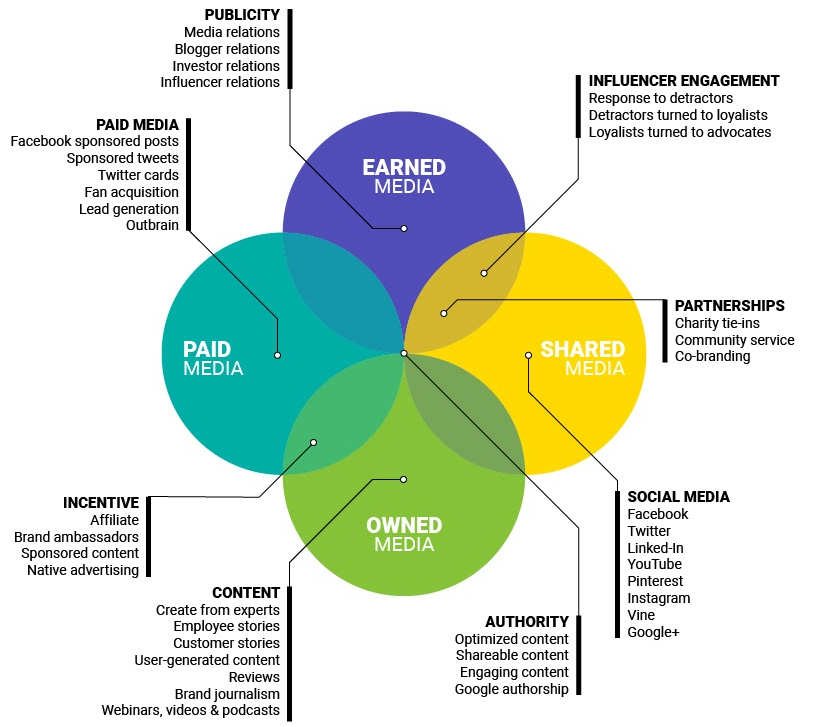
Image Credit
Paid Media for Online Reputation Management
Paid media implies all online content that requires payment to feature your brand (website, services, etc.). It involves channels like Google Ads, social media ads, sponsored posts, or promotions by influencers.
This aspect of ORM is fairly straightforward — you have full control over your own placements. You have to carefully check, though, if any of your competitors are advertising “against” your brand.
However, most paid media platforms have strict guidelines against such practices, and a single complaint can resolve this negative sentiment implication.
Earned Media
Earned media embraces the coverage that your brand receives from external platforms free of charge. They include:
External articles, Press coverage Blogs and Vlogs Forums Some industry-specific third-party listings (Glassdoor, Capterra, Trustpilot would all fall into this category).Google My Business would also count as earned media as customers leave reviews for your business without you controlling it. Earned media should be a focus for all businesses; these sources help create a positive outlook and create trust with online visitors.
Shared Media
On top of your website, your business’s accounts across various social networks are the online version of your business card.
Unaddressed complaints, negative comments on Twitter, and low star-rating on Facebook can seriously harm your company’s reputation and turn potential customers off. You should pay attention to what is happening on your Twitter wall the same way you would treat the walls of your brick-and-mortar establishment.
It is important that you track what brand mentions are popping up within other accounts as well and address the mentions that negatively portray your business.

Image from: Social Media Tracker tool
Owned Media
Owned media largely relates to your website and blog — the properties that are under your full control. So, if you work on improving the ranking of the pages that are of utmost importance to your brand’s reputation and perception, you are on the right track.
Although your online reputation management job gets easier when you deal with online spaces you control, don’t forget that you have to establish an all-encompassing ORM process. As Google’s Danny Sullivan has put it when talking about Google, “We’re not a truth engine. We can give you information, but we can’t tell you the truth of a thing.”
Basically, he implies that Google will showcase whatever is the highest-ranking page for your branded search. So, popularity matters, and not the inherent truth. Thus, you should focus on all the channels your brand gets mentioned on and try to manage your reputations across all of them.
Why Reputation Management Is Important for Your Online Business
We have explained why online reputation management for your brand is critically important. However, let’s get into how exactly an efficient ORM strategy can benefit your business.
1. Impact on Buying Decisions
The lack of online review management can actually cost you your customer base. As 81% of buyers do some online research before making a purchase, the way you appear online is the make-it-or-break-it factor in their final decision. And your online reputation really a business quality check with 88% of consumers reading reviews to determine if your business is reliable enough.
2. It Is the Online Version of Word-of-mouth
85% of consumers treat online reviews as personal recommendations and trust them as much as a tip from a friend. It is a great thing if your reviews are impeccable, but what happens if there was some bump on the road and someone posted a well-grounded negative comment?
In the age of social media when news spread like wildfire, it can be an absolute bombshell.
United Airlines lost over $1 billion in market value after a video of a passenger being violently forced away from an overbooked flight went viral. The video earned over a million mentions a day and over 100 million views. The CEO of United Airlines was accused of failing to deal with the situation and the lack of PR crisis management.
Nestlé also faced a notorious failure in reputation management when they were publicly accused by Greenpeace of harmful environmental practices. While Nestlé failed to react to the rising social media crisis, it even worsened it by asking YouTube to remove the Greenpeace video. In the aftermath, the company was forced to temporarily shut down its public page as people started posting the altered version of their Kit Kat logo all over the web.

Image from: AdWeek
3. There Is No “Delete "Button for Negative Reviews
It is not only the North that remembers. The Internet keeps everything, well, almost. Whatever people are saying about your business online is likely to stay online, but you actually have a chance of altering a negative opinion about your business.
By using a proper response, you can turn an unhappy customer into a loyal fan. According to a Lee Resource study, 70% of customers who complained and got a satisfying response form the business will come back and do business again. Furthermore, Harvard Business Review published a study that revealed that customers whose complaints got handled in less than 5 minutes tend to spend more on future purchases from your business.
4. You Can Get Valuable Feedback
Monitoring is a critical part of managing your online reputation. You can start collecting some useful insights on customer satisfaction and feedback regarding your product or services. So before doing some polling, surveys, and going around the globe for customer feedback, you can simply pay attention to what your customers have to say about your business.
How to Manage Your Brand’s Online Reputation
You need a process you can put in place for successful online reputation management. Of course, the process will vary from company to company, depending on your size, your industry, and your resources. But take the eight rules we outline below as the key milestones for establishing an efficient ORM strategy. You can elaborate it or shrink it, but the key steps will remain the same.
1. Perform an Audit of Your Online Reputation
Before putting any ORM process in place, you have to conduct an extensive online reputation audit.
Basically, the idea of an online reputation management audit has to do with uncovering how people see you online and what kind of issues you are facing in challenging that view. And to do that, you have to do some brand monitoring.
Brand Monitoring
Clearly, there is a way to conduct some quick audit of your brand reputation manually:
Just open up an incognito window and enter your brand name into Google search.
Take a good look at the sites that appear on the very first page.
Identify what Google My Business-related features come up on that page and evaluate your presence there: ratings, comments, reviews, user-generated photos, etc.
Separate the websites into the ones you control and the ones you have limited power over. With your social media accounts, they are highly manageable; with third-part listings, you can reach out to site owners and add/remove misleading bits. With a critical news piece, you can reach out to the author and try to talk to him about his dissatisfaction or convince them that they have got a wrong perception of your company or product.
Read through the reviews on these sites and try to understand the general sentiment; this is an important step for further prioritization over the platforms that require the most urgent attention.
Certainly, at this stage, this may seem like an exhausting process to conduct the audit manually. Below you will see how Semrush’s Brand Monitoring — a tool designed to help you manage online reputation — can give you a helpful overview at the end of an audit.
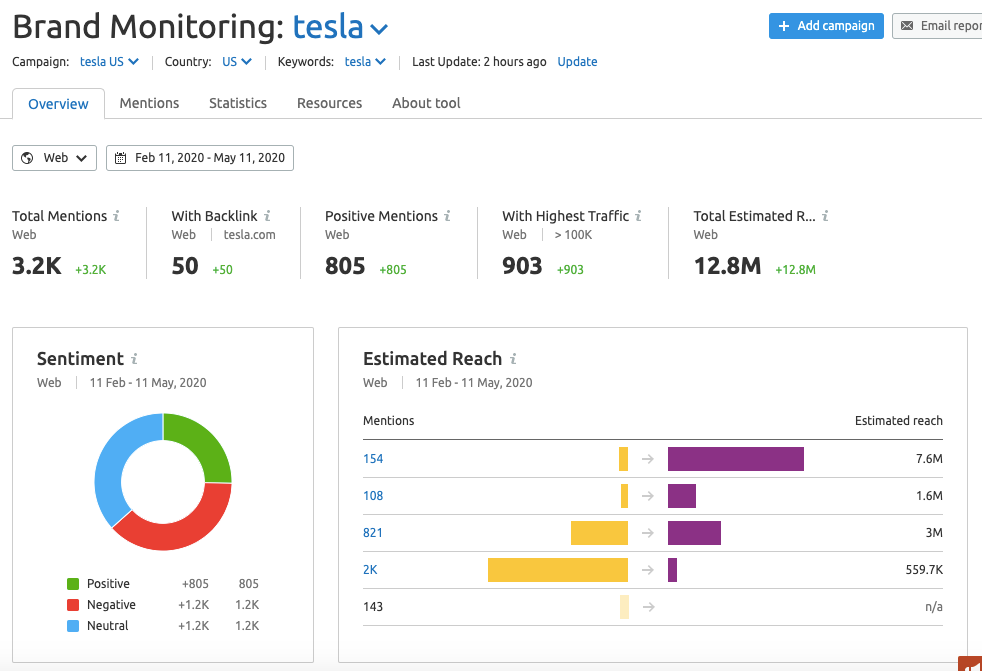
By and large, your audit has to help you answer the following questions:
What top websites within my search results do I have control over?
What kinds of websites do I see appear for my brand name?
Am I popular online (look at the number of mentions)?
Do most visitors find my business from search engines or external sites (check your Google Analytics -> Traffic Sources)?
Is the overall sentiment for my business positive (including neutral) or negative?
2. Establish an Online Reputation Management Strategy
Now when you know what the online landscape around your brand is, it is time to set up an online reputation management strategy. However, before we get into details about it, you have to get your priorities straight.
ORM Prioritization
Getting started with online reputation management can seem overwhelming. Thus, prioritization is of paramount importance, as you cannot jump on every single mention. Once your audit is complete, it should be easier for you to prioritize what you should focus on first. Try to balance out a few factors that should impact your decision:
Set up your online reputation management goals: If it is about response time, it is wise to focus on platforms you have direct access to. You can filter out your mentions within the Brand Monitoring tool by these criteria and monitor those.
Define your boundaries and limitations: Review how many resources you can allocate for the ORM project. And keep in mind that this is an ongoing process. So be realistic in your assessment.
Prioritize your ORM by impact: Although you may feel like you have to deal with everything at the same time, be realistic about the scope of the job. Impact is the biggest criterion for your choice as you have to try and allocate your resources into the channels with the highest stakes for your business.
Prioritize tasks: Which tasks are critical and must be addressed first? There should be a plan for handling critical and challenging tasks. Choosing the easier tasks to get done first isn't always the best option.
So, by considering these factors, you can create a matrix like the one below, and whatever channels appear within these criteria the most could be the ones you start your work on.

Image Credit: Reputation Defender
Policy Definition, Guidelines & Tone of Voice
To be successful at ORM, there is some red tape you have to go through. It is crucial to establish company-wide guidelines and tone of voice when dealing with online reputation. Once again, the scope of these policy docs will vary from business to business, but the general idea will stay.
Policy Documentation
Once you start your ORM project, you will always be alerted about a new comment, review, or other types of mentions. So, it is important to have a somewhat strict definition of what is urgent and what can wait, who is in charge, and how to respond.
Urgent/Non-Urgent response
You have to define what kinds of reviews are of the utmost urgency for your business. If your customers are surfing through Reddit frequently and any negative info there can be a deal-breaker for your product, pay special attention to mentions from there. You can also prioritize cases by importance to your brand and customers.
Urgent: By and large, cases that can be detrimental to your brand’s reputation go way beyond a casual negative comment. Also, don’t forget to review the profile of a person who wrote the review; if it is someone popular in some circles, you may anticipate some potential for virality. So, once you discover such a review, you have to take care of it straight away.
Non-Urgent: Normally, a non-urgent response is okay when you are dealing with cases that can be easily resolved by a typical response (maybe, a template you have prepared in advance for typical questions and concerns).
But even if you know an immediate response is not needed, still define the timeframe for responding to such comments. And make sure you’re reaching out to the commentator with an acknowledgment of their concern, even if it will take you a while to get back with a response.
Blacklist: Every business has come across trolls and pure haters who cannot be convinced to act reasonably. So, sometimes it is just better not to issue any official response because it will only escalate the conversation and lead to a more negative impact on your business. You can start a “blacklist” everyone can refer to when looking at your policy docs.
Response Templates
It is always a good idea to create a doc that includes FAQ about your brand. Keep all the answers within this doc so that your colleagues (and you) can use it as a general guideline for responding to reviews and comments.
Who Is in Charge?
If it is everyone’s responsibility, it is no one’s responsibility. So, clearly define who is in charge of a certain channel and try to stick to this policy. Collaborations are welcome, but it has to be clear to everyone where their responsibility begins and ends.
Tone of Voice
It is really important to establish a certain tone of voice for replying to negative (or, even positive) reviews and comments. For each brand, this part of the policy will vary, but make sure everyone is sticking to these guidelines.
Generally, it is a good idea to make sure you are not acting like a bully and not escalating any conflicts. Some conversations can be moved to DM, but even then, try to stick to your tone of voice rules as people can share private conversations publicly as well.
Have a Crisis Management Strategy in Place
You can never anticipate a crisis, but this doesn’t mean that you shouldn’t prepare for one. So, a sound crisis management strategy should always be in place as things escalate online at an unprecedented speed.
Clearly, this is a huge area to cover, so we won’t go in too much depth. But, generally speaking, there are a few things you have to prepare to be ready for an ORM crisis:
Make use of brand monitoring tools as they will quickly alert you if there are any unexpected conversation peaks about your brand.
Keep an eye on industry trends, as some legislation changes or the arrival of new cutting-edge technology can put your business under a lot of stress.
Know where your audience is and how to most efficiently communicate with them. If a large part of your audience is more active on Twitter, choose this channel as your primary communication space; this way, you will reach a wider audience in less time.
React quickly to every negative comment or review and draft a copy of your response as quickly as possible. But make sure no one copies & pastes it in mass — at the time of a crisis, your response should look tailored to each comment and personal.
Set up a chain of command beforehand, as everyone should know what their roles are in advance, especially when your colleagues are facing a crisis and may lose their cool.
3. Monitor Brand Mentions Efficiently
Being proactive in monitoring online conversations provides you with a real-time view of your online presence and gives you an opportunity for a timely reaction. However, it is not just about checking what reviews rank on Google.
To efficiently manage and monitor brand mentions, you can use the Semrush brand monitoring tool.
Here, you can set up a campaign to monitor the web for mentions of your brand, products, and people to make sure you always know what others are saying about you. And you can jump straight in and attempt to resolve any negative mentions or references.
How to Monitor Your Online Reviews Efficiently
Once you have entered your brand name and domain, you will be walked through the set-up process, choosing your target country, brand keywords, and will have the ability to schedule daily, weekly, or monthly email reports.
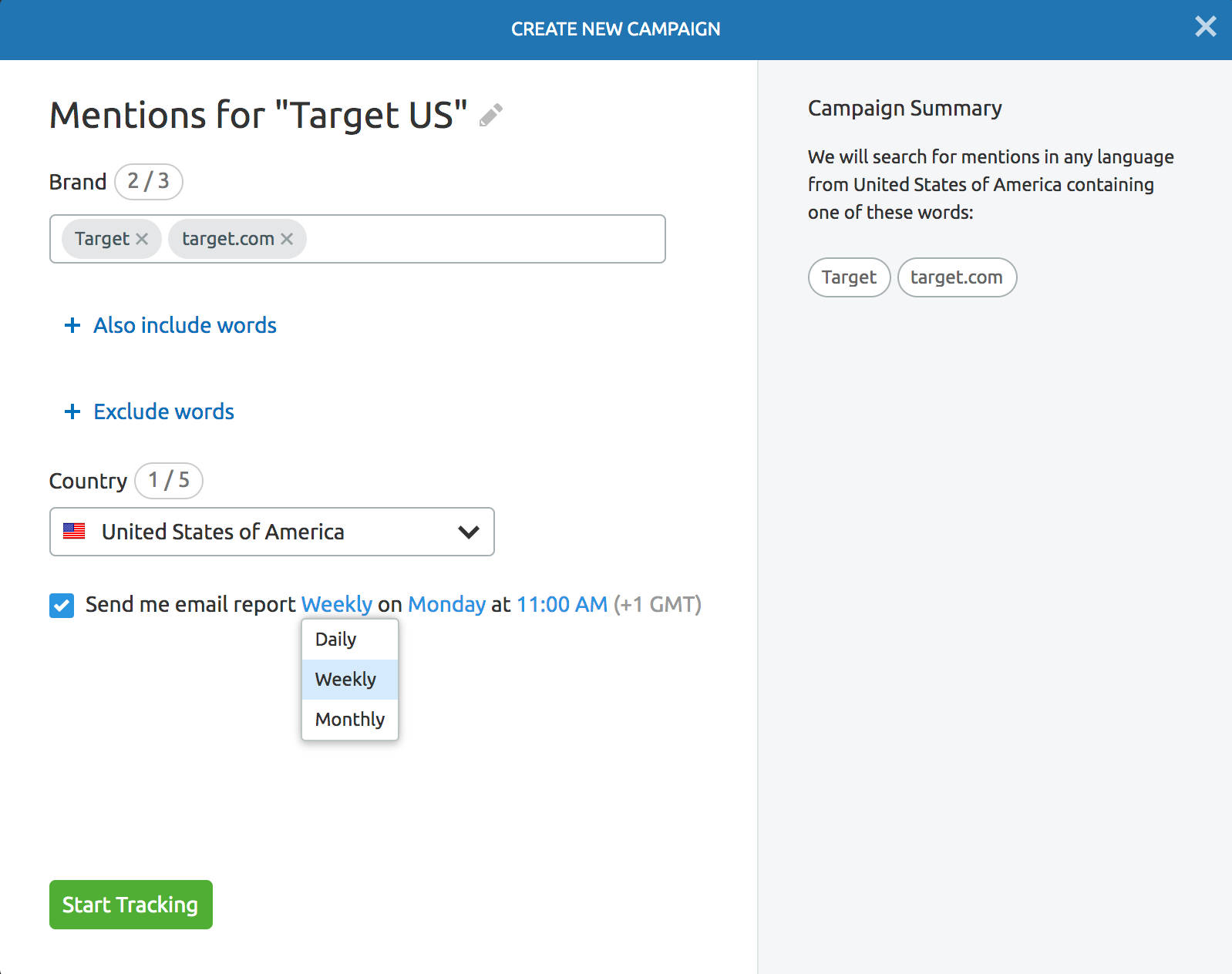
How frequently you should schedule reports very much depends on how often you are mentioned online; it is dependent upon the activity and scope of your business in many ways.
Once set up, the tool will return a whole host of brand mention insights for you:
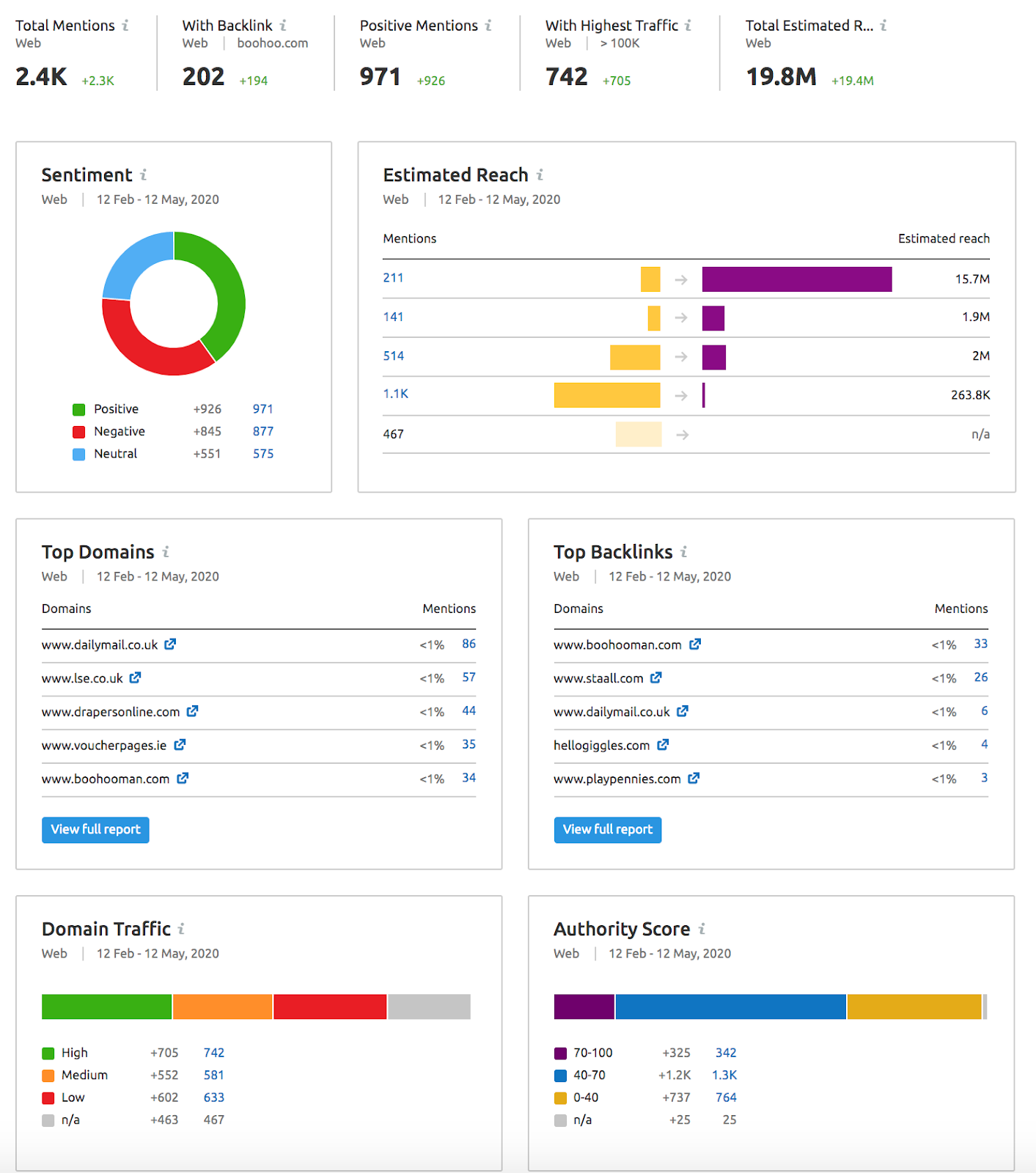
You will be able to understand, from the dashboard and reports, the overall sentiment of brand mentions across the web (a great way to quickly understand whether people’s perception is positive, neutral, or negative), as well as to see specific mentions (both in terms of sentiment and those with highest traffic potential and estimated reach).
4. Dominate SERPs for Brand Searches
No successful online reputation management strategy takes place without some SEO magic. Your main job is to show up on the SERPs for your branded keywords. The best way to get there is to have a website that ranks highly. Also, focus on optimizing your official social media channels, as these sites typically appear within the top 10 for branded searches.
But chances are, you won’t fill the entire space with your owned media. Here is how you can review what sites to look out for to give away a positive vibe within SERPs for your brand searches.
Define Your Branded Keywords
“A Branded keyword is a query that includes your website’s brand name or variations of it and is unique to your domain.” — Semrush KB.
You can try to determine these keywords yourself, but why guess? You can make use of online software that will do the job for you. Semrush’s Organic Positions report can help you determine your branded keywords by filtering them out from the entire keyword list your domain ranks for.
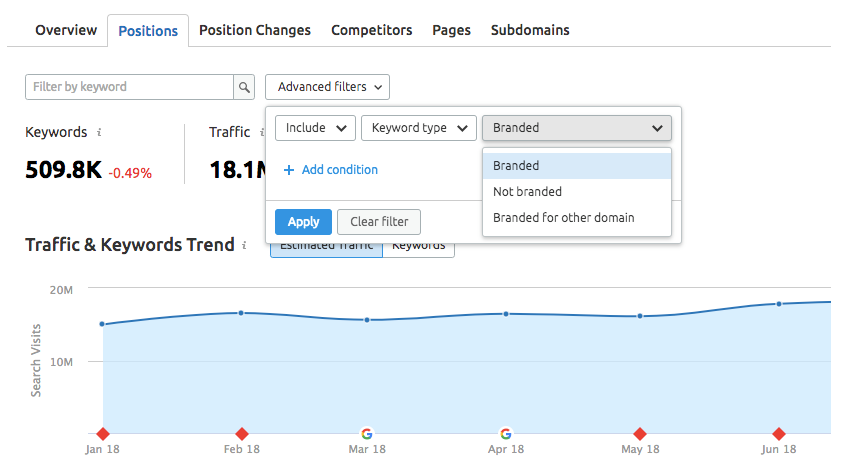
You should identify the branded keywords with the highest impact. Quickly check the search volumes for each branded keyword to prioritize between them. Create a list of branded keywords that are your top priority.
Next, check the SERP for your top-priority list and negate negative content. You can access the SERPs for the keywords of your choice from within Semrush:

Or, you can just manually enter the keyword as a search query on Google (make sure you are using Incognito mode). Look through the first results page and identify the negative spots you should work on. There are a few things you can do about external reviews and platforms:
If it is about Google My Business reviews, reach out to your loyal customers, and ask them to leave positive reviews to balance out the negativity and increase your rating.
If there is some negative content ranking for your branded keyword, try to contact the author of that negative piece and ask them to rectify it. Of course, you have to provide well-grounded reasons as to why their criticism may be irrelevant now — maybe, you have fixed something they were unhappy about or are currently working on some improvements.
Another way to “beat” that external negative piece is to create content that would outrank it. This how-to on creating SEO-friendly content should help you with these efforts.
5. Encourage Positive Reviews Online
Negative or positive, online reviews will impact your business and sales. Dimensional Research uncovered that positive online reviews affect 90% of buyers buying decisions. And 86% of users will think twice about choosing your brand if it has negative reviews. And people’s expectations about your reputation are pretty high. In fact, 49% of consumers expect a four-star rating from a business they will consider buying from them.
Dan Gingiss, @dgingiss:
“Don’t be afraid to ask for a review, but only after you know you’ve provided a remarkable experience. People share experiences they love and can’t stand; no one shares a so-so experience.Find the parts of your customer journey where you know your customer is happy, and then subtly ask (like including a social share link).”
We can see that modern-age consumers heavily depend on online reviews when making a purchase decision, but there is also a search engine optimization aspect to this. Your brand’s online reputation can impact your rankings. Google confirmed that its algorithms are wired to downrank sites that provide poor customer experience, and negative customer reviews signify such a pattern.
But with the exponentially growing number of opportunities for consumers to make their reviews public, it is often hard to know where to look and how to handle negative reviews.
How to Get Your Customers to Leave a Review
The easiest way to deal with negative reviews is to outweigh them with positive ones. So, you should also have a strategy in place to encourage customers to leave a review. This can be done on both quid pro quo basis and just in good faith.
Encourage your customers — in person is good, in email newsletters, and in your place of business with your free Google Marketing Kit.
You can create a small pop-up whenever someone visits your website, asking them to leave a review. Make sure to make it as easy as possible. Provide relevant links, and always thank them at the end of the message. And try not to send them to platforms that require too much effort like requiring sign-ups, personal details, etc.
Use your social media channels and find a fun way to encourage your customers to leave a review. It can be a special hashtag day for thanking your colleagues for an amazing job they're doing, or just a fun video provoking a good vibe.
And don’t forget about the power of email signatures. Add a line about the fact that you would very much appreciate a review of your customers' experience with your brand. And as we mentioned above, don’t forget to give them a clear direction of where they should go.
Establish an incentive program, but not for Google. This is against their guidelines.
If you feel like you would like to provide better motivation for leaving a review, you can come up with a special encouragement program. Say, per each review, a customer gets X points. After receiving Y points, they can count on a discount, a charitable donation, free publicity (you can feature them on your social media channels), or a unique piece of content. Just use your imagination and experiment with the specifics of the program.
And don’t forget to thank every customer that leaves a positive review. After all, they have put in their time and effort to assist your business and leave a nice review, so this much is expected from you in return.
Although a simple thank you should suffice, it is nice to come up with a more personal touch to your courtesy reply. Showing your customers that you care will incentivize them to keep coming back and maybe leaving more reviews!
6. Managing Negative Online Reviews
Bad reviews have a direct impact on your business’ bottom line as they discourage your existing and potential customers from using your services or product. We discussed this at length in a recent #Semrushchat.
ReviewTrackers survey unveils that 94% of consumers admit that a negative online review can turn them off choosing a particular business.
Before addressing your negative reviews, make an assessment of the most problematic reviews. Reviews that rank highly in the SERP are a great starting point. Quickly run through the following platforms:
Google My Business
Social media platforms (Facebook, LinkedIn, Twitter, Instagram, etc.)
Trustpilot, Feefo, Review.io or similar (don’t forget that some of these platforms can gather reviews even if you don’t subscribe)
It is important that you capture a regular snapshot of your online reviews so that you can deal with issues effectively.
How to Respond to Negative Online Reviews
As we have already mentioned, you should already have a solid strategy in place on how you deal with negative reviews. And you know that your blacklist of trolls and haters might not be worth your time. However, you need to address bad reviews.
Once again, and it cannot be overstressed, ignoring negative reviews is the worst policy you can come up with. Answering such reviews showcases that you, as a brand, truly care about each and every customer and go to some great lengths to resolve their issues. According to a study from RightNow, 34% of consumers will remove their original bad review once they hear back from the business.
Konstantinos Ntoukakis, @kntoukakis:
“My philosophy is to always respond to reviews, positive or negative — that's how you grow. Never reply to trolls though, it's like fueling a fire? Also, it goes without saying but *never delete* reviews.”
Here are some tips on how to respond to a negative review/comment:
Improve Your Response Time
Negative comments are very time-sensitive. The earlier you address them, the less impact they convey. Using the management strategy you have in place, work on improving the speed of your replies. At the same time, don't respond without have a plan first; avoid saying something in a hurry that will hurt you in the long run.
Builder Designs, @builderdesigns:
“1. Take time to craft a thoughtful response.2. Respond publicly and direct further conversation offline.3. Follow up to make sure their concerns were addressed.”
Show Courtesy
Your answer should always start with a simple thank you, a common courtesy, for their feedback and time.
iPullRank Digital Marketing Agency, @iPullRankAgency:
“Responding to positive reviews can show potential customers you are grateful for their feedback, and responding to negative or neutral reviews can add insight into WHY they had a bad experience so you can improve.”
Being polite will always make your brand look more appealing, especially if you are not giving in to provocation and rudeness. This will only highlight the contrast between a pleasant brand and a raging critic, especially if there is a rude review.
Apologize If You Are Wrong (with one exception)
If you are at fault, you should extend your apologies. Tell the reviewer that you have pinpointed where the problem came from and are now working on a solution. You can even ask them to actively participate and provide insights on your newly-designed solution. However, keep and mind that some apologies could result in legal action. If you have a possible legal issue, you can still show empathy without putting the company at risk:
“We understand your frustration.” “How can we make this better?” “We want to provide better services for you; tell us what you need.”Showing understanding and empathy will go a long way with customers.
Amy Balliett, @AmyBalliett:
“1. Listen to their perspective & try to truly understand it2. Always reply with empathy and understanding, not confrontation3. Don't apologize when you didn't do anything wrong, but apologize when you did, and promise to do better4. Do better”
Public and Private Communication
We strongly encourage you to address most of the negative comments in public. This can help negate the impact of the bad review and show others that you are very responsive and approachable.
However, some reviews require more in-depth conversations that may involve some sensitive data. So, publicly mention that you will have to disclose some specific things that aren’t public to continue the conversation and suggest moving the conversation into private channels.
Tallwave, @Tallwave:
“It is important to be humble and apologetic, offer the customer a solution, and then try to take the conversation offline as soon as possible — give them a number to call or email to contact you directly in order to remedy the situation.”
Offer a Refund/Discount
This tactic should be the last resort for your reputation management strategy. However, there might be a case where this approach is the best option there is, especially if your product or service is really to blame.
With messages about refunds, it is best to address them in private as there might be some misunderstanding from other customers who don’t understand why someone qualifies for a discount or a refund, while they don’t.
Make Improvements to Your Service/Product
If you spot that some complaints are recurring consistently, consider actually making changes to your business. The same complaint from multiple customers is an indication that something is wrong on your side. Make sure to keep everyone posted on what measures you are undertaking to get the issue resolved.
How to Push Negative Reviews Down the SERPs
Up to now, we were describing the cases when all parties were reasonable and objective in their negative feedback. Unfortunately, sometimes this is not the case. If you have exhausted all your efforts to reach some agreement with a publisher of a highly biased piece, yet that content ranks high for your branded keywords, there as a possible workaround.
In short, you need to rank a positive article, or an owned profile of your own, up above the problematic one. These reviews rank either because they are placed on a very authoritative platform or because they have backlinks to them.
So, to rectify this situation, you need to push the negative content onto page 2 of Google; or further down if possible. Here are 4 things you can do:
Creating and earn great and positive content that outranks the negative piece. Work to secure product or service reviews on high-profile sites (even if that means paying for advertorials or sponsoring content) Work with influential bloggers or work alongside your PR team.It is not a quick fix, but it is an approach that should maintain the results and hide the negative article.
7. Create Content that Is Always On-Brand
There is another side of online reputation management we have to mention — branding. We don’t just mean the visual aesthetics, although important as well, but the general consistency of messaging and tone of voice.
The content your customers initially stumble upon when looking up your brand will largely shape their perception of it. So, by having a solid ORM strategy in place, you have the power to project yourself in the way you want to be seen.
So, how your content appears for your branded searches, the replies you give across review platforms, and your social media communication, they all play a part in shaping your image in the eyes of your customers.
8. Choose Your Influencers Wisely
When talking about online reputation management, we cannot ignore its newest angle for many businesses, influencer marketing. This may seem like a great substitution for paid media, but you do not have the same control over the reputation as you do with ads and sponsored posts.
Just think about the 2017 scandal with Disney’s Maker Studios and PewDiePie. Maker Studios employed one of the most famous online personalities to be a part of their promotion strategy, but humans are very unpredictable. PewDiePie provoked a huge controversy and Disney’s entity was forced to cancel the contract with the famous and now notorious vlogger straight away. Even with a rapid response, this incident should have affected the company’s reputation.
We certainly don’t mean to discourage you completely from using influencer marketing as a part of your online reputation management strategy. You just have to be very careful when choosing the right person to work with. And even people you are absolutely certain about might not be the best choice for associating your brand name with. For instance, Michelle Obama may be an impeccable person to ask for a feature, yet if you have a large Republican customer base, this may not be the best idea.
If you have decided you are ready to invest in some influencer marketing, here is how you can approach the influencer picking process:
When dealing with high-end influencers:
Try to pinpoint the ones who aren’t already “taken” by your competitors and best fit your brand image.
If you spot a mention from an influencer during your online reputation audit, reach them out and thank them for the mention. This can become a conversation starter, even if their review wasn’t absolutely favorable. You can get a chance to create a better pitch for your product and service and turn them into your brand ambassadors.
When identifying an aspiring brand ambassador:
Check who mentions your brand most frequently (in Semrush’s Brand Monitoring tool, there’s a special tab called Mentioners). Look at the count of their followers on Twitter, and check how active they are on forums that are relevant to your industry.

Check their Instagram profile and look at the general sentiment of their posts mentioning you.
 Add the mentioner to favorites to work on your outreach later. Once you create a list of mentioners with high potential to become your brand ambassadors and with high follower count, you can prioritize your outreach efforts.
Add the mentioner to favorites to work on your outreach later. Once you create a list of mentioners with high potential to become your brand ambassadors and with high follower count, you can prioritize your outreach efforts.To Recap
Online reputation management is only a reflection of this new “bottom-up” communication where your existing and potential customers get a voice around your brand. So, ORM is an essential part of any business, marketing, and growth strategy for any business out there (even the businesses that aren’t yet online). People are talking about you and will continue to do so. Your job is to set up a solid online reputation management strategy to navigate through all the online conversations, provide fixes here and there, and provoke positive sentiment.
We hope this guide will serve as a great starting point for your online reputation management efforts. In the meantime, if you feel like we’ve missed something important or you would like to share your own ORM experience, please put your thoughts down in the comments.
Innovative SEO services
SEO is a patience game; no secret there. We`ll work with you to develop a Search strategy focused on producing increased traffic rankings in as early as 3-months.
A proven Allinclusive. SEO services for measuring, executing, and optimizing for Search Engine success. We say what we do and do what we say.
Our company as Semrush Agency Partner has designed a search engine optimization service that is both ethical and result-driven. We use the latest tools, strategies, and trends to help you move up in the search engines for the right keywords to get noticed by the right audience.
Today, you can schedule a Discovery call with us about your company needs.
Source:





